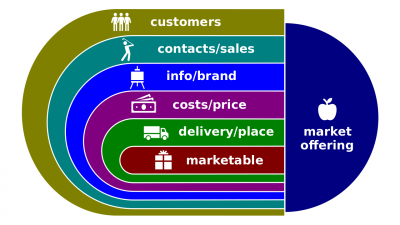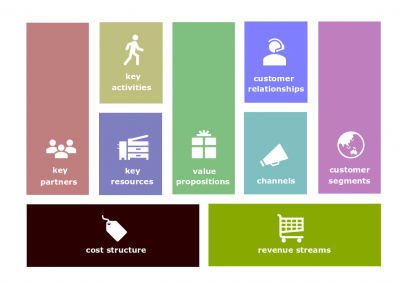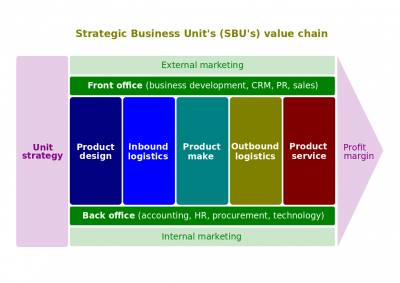Difference between revisions of "Marketable"
(→The 4As) |
|||
| (69 intermediate revisions by the same user not shown) | |||
| Line 1: | Line 1: | ||
| − | [[File:Product.png|400px|thumb|right|[[ | + | [[File:Product.png|400px|thumb|right|[[Marketable]]]]In [[marketing]], a [[marketable]] (alternatively known as [[marketing mix]], [[market-offer mix]], [[market-offering mix]], [[market-offering model]], and, when already marketed, [[market offering]]; hereinafter, the ''Mix'') is a [[model]] representing distinguishable components of [[market offering]]s. The ''Mix'' represents the aggregate of components of [[market offering]]s that a [[business]] handles in order to make consumers be aware of, influence them to purchase, and get the benefits from its [[market offering]]s. |
==Components== | ==Components== | ||
| − | === | + | ===Exchangeable=== |
| − | [[ | + | :''Main wikipage: [[Market exchangeable]]'' |
| + | |||
| + | :A [[market exchangeable]] can be divided in an [[unpackaged deliverable]] and [[packaging]]. | ||
===Delivery=== | ===Delivery=== | ||
| − | :[[Product delivery]]. The action of delivering [[ | + | :[[Product delivery]]. The action of delivering [[market exchangeable]]s either ordered or for sale. [[Delivery personnel]] may be incorporated and important for this ''delivery''. |
===Charge=== | ===Charge=== | ||
| − | :[[Product charge]]. A payment asked for a [[ | + | :[[Product charge]]. A payment asked for a [[market exchangeable]]. Not only its [[price]], but also [[financing]] and acceptable [[payment method]]s may be incorporated in and important for this ''charge''. |
===Presentation=== | ===Presentation=== | ||
| − | :[[Product presentation]]. The proffering or giving of a [[ | + | :[[Product presentation]]. The proffering or giving of a [[market exchangeable]] to its potential consumers, particularly, through product manuals, official website, and [[public relations]]. [[Branding]] is the marketing practice of creating a name, symbol, or design that identifies and differentiates a [[market exchangeable]] from other [[market exchangeable]]s. |
==Basic tools== | ==Basic tools== | ||
| Line 22: | Line 24: | ||
===The 4Ps=== | ===The 4Ps=== | ||
| − | :#'''[[Product]]''' refers to the [[deliverable]] that its [[seller]] offers for sale. This may include its | + | :The [[4Ps]] (alternatively spelled, [[Four Ps]], [[4 Ps]], or [[4P's]]; also known as [[4Ps of marketing]]) is the oldest ''Mix'' tool. |
| − | :#'''[[Price]]''' refers to the total cost to customer to acquire the product, and may involve both monetary and psychological costs such as the time and effort spent in acquisition. The [[product charge]] | + | :#'''[[Product]]''' refers to the primary [[deliverable]] that its [[seller]] offers for sale. This may include its benefits, brand name, design, features, grade, guarantees, life cycles, packaging, returns, services, size, style, and warranties. |
| − | :#'''[[Place]]''' refers | + | :#'''[[Price]]''' refers to the total cost to customer to acquire the product, and may involve both monetary and psychological costs such as the time and effort spent in acquisition. The [[product charge]] may include allowances, credit terms, discounts, list prices, payment period, and special offer prices. |
| + | :#'''[[Place]]''' refers to the [[marketing channel]]s. This may include physical and virtual locations where a business carries out business, where sales and service occur, as well as delivery points for [[marketing communications]], [[deliverable]]s, [[inventory|inventori]]es, and after-sale services. This may include [[call center]]s, logistics, order fulfillment centers, retail outlets, territorial coverage hubs, transport, virtual stores, and [[website]]s. | ||
:#'''[[marketing communications mix|Promotion]]''' refers to the [[marketing communications mix]] used to make the offer known to potential customers and persuade them to investigate it further. | :#'''[[marketing communications mix|Promotion]]''' refers to the [[marketing communications mix]] used to make the offer known to potential customers and persuade them to investigate it further. | ||
===The 4Cs=== | ===The 4Cs=== | ||
| − | :If [[#The 4Ps|the 4Ps]] reflects the [[seller]]'s side, the 4Cs tries to capture the [[buyer]]'s one: | + | :If [[#The 4Ps|the 4Ps]] reflects the [[seller]]'s side, the [[4Cs]] (alternatively spelled, [[Four Cs]]; also known as [[4Cs of marketing]]) tries to capture the [[buyer]]'s one: |
:#'''[[Consumer demands]]''' as opposed to the [[product]]. Consumers buy [[product]]s to solve particular problems and satisfy particular needs. | :#'''[[Consumer demands]]''' as opposed to the [[product]]. Consumers buy [[product]]s to solve particular problems and satisfy particular needs. | ||
:#'''[[Cost]]''' as opposed to the [[price]], which is only a part of the total cost to satisfy customer's demand. | :#'''[[Cost]]''' as opposed to the [[price]], which is only a part of the total cost to satisfy customer's demand. | ||
| Line 35: | Line 38: | ||
===The 4As=== | ===The 4As=== | ||
| − | :Although [[#The 4Cs|the 4Cs]] tries to capture the [[buyer]]'s side, the 4As attempts to capture its drivers: | + | :Although [[#The 4Cs|the 4Cs]] tries to capture the [[buyer]]'s side, the [[4As]] (alternatively spelled, [[Four As]]; also known as [[4As of marketing]]) attempts to capture its drivers: |
:#'''[[Acceptability]]''' is the extent to which the ''Mix'' exceeds customer expectations. This includes the core benefits, [[reliability]], and other properties of the [[deliverable]], as well as its psychological acceptability that resulted from its [[branding]], packing, and positioning. | :#'''[[Acceptability]]''' is the extent to which the ''Mix'' exceeds customer expectations. This includes the core benefits, [[reliability]], and other properties of the [[deliverable]], as well as its psychological acceptability that resulted from its [[branding]], packing, and positioning. | ||
:#'''[[Affordability]]''' is the extent to which customers in the [[target market]] are able and willing to cover the product's costs. [[Affordability]] has two dimensions, which are (a) economic affordability or ability to pay and psychological affordability or willingness to pay. | :#'''[[Affordability]]''' is the extent to which customers in the [[target market]] are able and willing to cover the product's costs. [[Affordability]] has two dimensions, which are (a) economic affordability or ability to pay and psychological affordability or willingness to pay. | ||
| Line 50: | Line 53: | ||
:#'''[[Physical evidence]]''' refers to the [[tangible]]s or non-human elements of the service encounter, including equipment, furniture and facilities. | :#'''[[Physical evidence]]''' refers to the [[tangible]]s or non-human elements of the service encounter, including equipment, furniture and facilities. | ||
| − | + | :All together, they compose the [[7Ps]] (alternatively known as [[7Ps of marketing]]). | |
| − | |||
| − | |||
| − | |||
| − | |||
| − | |||
| − | |||
| − | |||
| − | |||
| − | |||
| − | |||
| − | |||
| − | |||
| − | |||
| − | |||
| − | |||
| − | |||
| − | |||
| − | |||
| − | |||
| − | |||
| − | |||
| − | |||
| − | |||
| − | |||
| − | |||
| − | |||
| − | + | ===The 7Cs Compass=== | |
| − | + | :[[File:Business-model-canvas.png|400px|thumb|right|[[Business Model Canvas]]]]None of [[#The 4Ps|the 4Ps]], [[#The 4Cs|4Cs]], [[#The 4As|4As]], or [[#The 7Ps|7Ps]] address the influence that the [[organization]] has on the ''Mix'', as well as the fact that customers are often a part of the ''Mix'' for [[service]]s. The [[7Cs Compass Model]] (alternatively known as [[7Cs]], [[Seven Cs]], and [[7Cs of marketing]]) tries to capture those: | |
| − | + | :#'''[[Corporation]]''', which is offering its ''Mix'' to the [[market]]. | |
| − | + | :#'''[[Commodity]]''', which refers to the [[product]] what the customer gets. | |
| + | :#'''[[Cost]]''', which refers to the price and other costs that the customer pays. | ||
| + | :#'''[[Channel]]''', which refers to the [[place]] and [[convenience]] in other tools. | ||
| + | :#'''[[Communication]]''', which refers to the [[marketing communications mix]]. | ||
| + | :#'''[[Consumer]]''', which, using the cardinal directions of the compass, indicates N = Needs; S = Security; E = Education (i.e. consumer education); and W = Wants. | ||
| + | :#'''[[Circumstances]]''', which, using the cardinal directions of the compass, indicates N = National and international environment; S = Social and cultural; E = Economic; and W = Weather. | ||
| − | + | ===The New 4Ps=== | |
| + | :''Main wikipage: [[Strategic business unit]]'' | ||
| − | + | :[[File:Value-chain-redefined.png|400px|thumb|right|[[Strategic business unit]] ([[Strategic business unit|SBU]])]]Any ''Mix'' tool concentrates on the activities directly related to the building, selling, and serving the [[market exchangeable]]. The [[concept]] of [[holistic marketing]] prompted some marketers to spread marketing endeavors throughout the whole business. Although the [[New 4Ps]] is not a ''Mix'' tool per se, its idea is to align every endeavor within the business with the marketing objectives: | |
| + | :#'''[[People]]''' implies two sides. On the one side, the employees are critical to marketing success since any [[marketing]] is as great as company's employees are. That also captions the [[internal marketing]] notion. On the other side, consumers are people and the business objective is to understand their lives more broadly, and not just view them as shoppers who consume [[market exchangeable]]s. | ||
| + | :#'''[[Process]]es''' reflects all the [[process]]es within the [[business]], including imaginatively generating insights and breakthrough products, services, and marketing activities. | ||
| + | :#'''[[Program]]s''' encompasses the old [[#The 4Ps|four Ps]] as well as a range of other marketing activities that might not fit as neatly into the old view of marketing. | ||
| + | :#'''[[Performance]]''' implies two sides. On the one side, it measures financial such as [[profitability]] and non-monetary such as brand and customer equity implications within the [[business]]. On the other side, it measures the impact beyond the ''business'' itself. That may include social responsibility, as well as legal, ethical, and environmental outcomes. | ||
| − | + | ===Comparison=== | |
| − | + | :The table below represents the approximate comparison of various tools:<table class="wikitable" width=100%><tr><td> </td><th>[[#The 4Ps|4Ps]]</th><th>[[#The 7Ps|7Ps]]</th><th>[[#The 4Cs|4Cs]]</th><th>[[#The 7Cs Compass|7Cs]]</th><th>[[#The 4As|4As]]</th></tr><tr><th>[[Market exchangeable]]</th><td colspan="2">[[Product]]</td><td>[[Consumer demands]]</td><td>[[Commodity]]</td><td>[[Acceptability]]</td></tr><tr><th>Customer's costs</th><td colspan="2">[[Price]]</td><td colspan="2">[[Cost]]</td><td>[[Affordability]]</td></tr><tr><th>Pickup or delivery</th><td colspan="2">[[Place]]</td><td>[[Convenience]]</td><td>[[Channel]]</td><td>[[Accessibility]]</td></tr><tr><th>Info and brand</th><td colspan="2">[[Promotion]]</td><td colspan="2">[[Communication]]</td><td>[[Awareness]]</td></tr><tr><th rowspan="3">Others</th><td rowspan="3"> </td><td>[[People]] (or personnel)</td><td rowspan="3"> </td><td>[[Corporation]]</td><td rowspan="3"> </td></tr><tr><td>[[Process]]</td><td>[[Consumer]]</td></tr><tr><td>[[Physical evidence]]</td><td>[[Circumstances]]</td></tr></table> | |
| − | |||
| − | |||
==Related lectures== | ==Related lectures== | ||
Latest revision as of 01:52, 10 June 2023
In marketing, a marketable (alternatively known as marketing mix, market-offer mix, market-offering mix, market-offering model, and, when already marketed, market offering; hereinafter, the Mix) is a model representing distinguishable components of market offerings. The Mix represents the aggregate of components of market offerings that a business handles in order to make consumers be aware of, influence them to purchase, and get the benefits from its market offerings.
Contents
Components
Exchangeable
- Main wikipage: Market exchangeable
- A market exchangeable can be divided in an unpackaged deliverable and packaging.
Delivery
- Product delivery. The action of delivering market exchangeables either ordered or for sale. Delivery personnel may be incorporated and important for this delivery.
Charge
- Product charge. A payment asked for a market exchangeable. Not only its price, but also financing and acceptable payment methods may be incorporated in and important for this charge.
Presentation
- Product presentation. The proffering or giving of a market exchangeable to its potential consumers, particularly, through product manuals, official website, and public relations. Branding is the marketing practice of creating a name, symbol, or design that identifies and differentiates a market exchangeable from other market exchangeables.
Basic tools
Several business tools are used to capture the Mix in marketing products.
The 4Ps
- The 4Ps (alternatively spelled, Four Ps, 4 Ps, or 4P's; also known as 4Ps of marketing) is the oldest Mix tool.
- Product refers to the primary deliverable that its seller offers for sale. This may include its benefits, brand name, design, features, grade, guarantees, life cycles, packaging, returns, services, size, style, and warranties.
- Price refers to the total cost to customer to acquire the product, and may involve both monetary and psychological costs such as the time and effort spent in acquisition. The product charge may include allowances, credit terms, discounts, list prices, payment period, and special offer prices.
- Place refers to the marketing channels. This may include physical and virtual locations where a business carries out business, where sales and service occur, as well as delivery points for marketing communications, deliverables, inventories, and after-sale services. This may include call centers, logistics, order fulfillment centers, retail outlets, territorial coverage hubs, transport, virtual stores, and websites.
- Promotion refers to the marketing communications mix used to make the offer known to potential customers and persuade them to investigate it further.
The 4Cs
- If the 4Ps reflects the seller's side, the 4Cs (alternatively spelled, Four Cs; also known as 4Cs of marketing) tries to capture the buyer's one:
- Consumer demands as opposed to the product. Consumers buy products to solve particular problems and satisfy particular needs.
- Cost as opposed to the price, which is only a part of the total cost to satisfy customer's demand.
- Convenience as opposed to the place. In the era of Internet, convenience takes into account the ease of buying the product, finding the product, finding information about the product, and several other factors.
- Communication as opposed to the promotion. The buyers look for cooperation rather than manipulation.
The 4As
- Although the 4Cs tries to capture the buyer's side, the 4As (alternatively spelled, Four As; also known as 4As of marketing) attempts to capture its drivers:
- Acceptability is the extent to which the Mix exceeds customer expectations. This includes the core benefits, reliability, and other properties of the deliverable, as well as its psychological acceptability that resulted from its branding, packing, and positioning.
- Affordability is the extent to which customers in the target market are able and willing to cover the product's costs. Affordability has two dimensions, which are (a) economic affordability or ability to pay and psychological affordability or willingness to pay.
- Accessibility is the extent to which customers are able to readily acquire the deliverable. Accessibility has two dimensions, which are (a) availability and (b) convenience.
- Awareness is the extent to which customers are informed regarding characteristics of the deliverable, persuaded to try it, and reminded to repurchase. Awareness has two dimensions, which are (a) brand awareness and (b) product knowledge.
- The combination of acceptability and affordability determines the value proposition.
Special tools
The 7Ps
- In addition to the 4P's, the following three P's might be added to describe the Mix of a service,
- People (or personnel) refers to the personnel that stand for the service. In the professional, financial or hospitality service industry, people are not producers, but rather the products themselves.
- Process refers to a set of activities that results in delivery of the product benefits including greetings and customer service actions.
- Physical evidence refers to the tangibles or non-human elements of the service encounter, including equipment, furniture and facilities.
- All together, they compose the 7Ps (alternatively known as 7Ps of marketing).
The 7Cs Compass
- None of the 4Ps, 4Cs, 4As, or 7Ps address the influence that the organization has on the Mix, as well as the fact that customers are often a part of the Mix for services. The 7Cs Compass Model (alternatively known as 7Cs, Seven Cs, and 7Cs of marketing) tries to capture those:
- Corporation, which is offering its Mix to the market.
- Commodity, which refers to the product what the customer gets.
- Cost, which refers to the price and other costs that the customer pays.
- Channel, which refers to the place and convenience in other tools.
- Communication, which refers to the marketing communications mix.
- Consumer, which, using the cardinal directions of the compass, indicates N = Needs; S = Security; E = Education (i.e. consumer education); and W = Wants.
- Circumstances, which, using the cardinal directions of the compass, indicates N = National and international environment; S = Social and cultural; E = Economic; and W = Weather.
The New 4Ps
- Main wikipage: Strategic business unit
- Any Mix tool concentrates on the activities directly related to the building, selling, and serving the market exchangeable. The concept of holistic marketing prompted some marketers to spread marketing endeavors throughout the whole business. Although the New 4Ps is not a Mix tool per se, its idea is to align every endeavor within the business with the marketing objectives:
- People implies two sides. On the one side, the employees are critical to marketing success since any marketing is as great as company's employees are. That also captions the internal marketing notion. On the other side, consumers are people and the business objective is to understand their lives more broadly, and not just view them as shoppers who consume market exchangeables.
- Processes reflects all the processes within the business, including imaginatively generating insights and breakthrough products, services, and marketing activities.
- Programs encompasses the old four Ps as well as a range of other marketing activities that might not fit as neatly into the old view of marketing.
- Performance implies two sides. On the one side, it measures financial such as profitability and non-monetary such as brand and customer equity implications within the business. On the other side, it measures the impact beyond the business itself. That may include social responsibility, as well as legal, ethical, and environmental outcomes.
Comparison
- The table below represents the approximate comparison of various tools:
4Ps 7Ps 4Cs 7Cs 4As Market exchangeable Product Consumer demands Commodity Acceptability Customer's costs Price Cost Affordability Pickup or delivery Place Convenience Channel Accessibility Info and brand Promotion Communication Awareness Others People (or personnel) Corporation Process Consumer Physical evidence Circumstances


